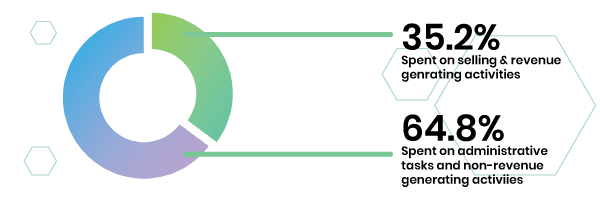
Ok, you’ve heard it before, but let’s revisit for sake of this post. Salespeople only spend about a third of their time actually selling.
What do we mean by this? We’re talking about revenue generating conversations, face-to-face meetings, phone calls, and screen sharing, just to name a few
As Bryan Parry stated in his article on InsideSales.com
Sales reps spend just over a third of their time (35.2%) actually selling.
So where is more than 60% of their time gone? For most sales professionals especially in the media space, a normal workday consists of them behind a computer screen. Doing what you say? In almost all cases, these hours normally consist of processing sold orders, creating new proposal decks, filling out buy sheets, and updating the dreaded CRM.

The Issue:
At some point along the way sales organizations placed the added responsibility of administrative tasks on sales reps who would be better utilized in face-to-face client meetings. Now, I’m not saying these administrative tasks are not important, in fact, they are crucial. Executive teams and sales directors rely on these documents, reports, and account statuses to stay on top of performance tracking and profit management.
Unfortunately for sales professionals, there is a lack of tools to streamline their workflow. So as a result, a majority of their workday around 4 to 5 hours is spent behind a screen working on time-consuming and frankly repetitive administrative tasks.
The Compound Effect
We speak mainly about lost sales time, but what does that really translate to? Losing 4 to 5 hours a day accumulates to 20 to 25 hours lost every work week which translates to 80 to 90 hours each month. That’s a profound number to grasp when you consider how many closed sales or proposals could have been made if these if more of these hours were dedicated to revenue-generating activities.
What would it mean to your company if you simply had 20% more sales time back in your hands? What does that translate to you in terms of revenue growth?
Sales and Technology Don’t Mix.
You might be thinking right now “What about CRM’s or Prospecting Tools?” You are right, kind of. CRM’s are valuable, in the sense that you understand where you stand with customer relationships and prospecting tools are beneficial to personalize your cold approaches and initial conversations. So let me rephrase, “Sales Time” and technology don’t mix. The tools mentioned, although valuable, don’t necessarily help to maximize time spent selling, and time is the culprit that’s hindering sales performance and profitability.
Shifting the Focus
So how do we as an industry, Media, in this case, change our mindset on arming our sales staff with the tools they need to perform to their full potential. Well, it all starts with breaking down the foundation of their current workflow. First, we ask,”What time-consuming task can be eliminated completely?” Next, “What task cannot be eliminated?” And finally, “Can we create automation around those tasks?” Understanding this way of organizational thinking opens the doors for solutions that can help reduce time spent on administrative tasks and maximize time spent on selling. If you’re a Sales Manager, Director, or VP, understanding the obstacles that prevent your sales staff from reaching their top performance is crucial to long-term revenue growth. We need to start thinking about what it is our salespeople do best and let them do just that. Even more importantly, we need to make organization-wide decisions to adopt technology that can help automate these inefficient workflows.
